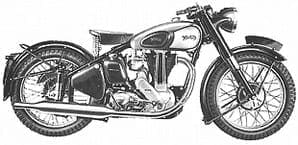
Of all the British motorcycle manufacturers, Norton Motors must surely have held the record for keeping what was basically the same model in production for the longest period. Their side valve models were discontinued in 1955 after 45 years of manufacture, and the overhead valve singles soldiered on in similar fashion. Even the overhead camshaft models had a lengthy run after Arthur Carroll had drastically redesigned the engine. Ironically, it was always the last mentioned that always got the most publicity, although they were more expensive and in consequence made in somewhat limited numbers. Norton were proud of their racing successes with this type of engine and only too pleased to make capital of their racing successes all over the world.
Motor Cycle Show
The model ES2 first saw the light of day at the 1927 Motor Cycle Show. Sharing the 79 x 100mm bore and stroke dimensions of the company's other 490cc models, it differed from the ohv model 18 by having a full cradle frame and dry sump lubrication. Although the majority of Norton's other models had been given a simple numerical code to identify them, the ES2 was one of a few exceptions. No one now seems to be sure of why the letters ES were used, although there may be some truth in the suggestion that they represented enclosed springs. Not, of course, the valve springs, which were still fully exposed to the elements. In those days, push rod return springs were a quite common fitment. Whereas the conical springs fitted to the base of the exposed push rods of the model 18 were there for all to see, the ES2 used longer springs of constant diameter enclosed within metal covers on the top of the timing chest.
Enjoy more Old Bike Mart reading in the monthly newspaper.
Click here to subscribe & save.
 As far as the ES2 was concerned, not a great deal of change took place in the years that followed. It was not until late 1937 that the engine was given a fresh appearance by bowing to convention and fully enclosing the valve gear. Although the 79 x 100mm engine dimensions remained unchanged, the push rods no longer ran parallel to each other. Now they were inclined inward at the top, where they joined an aluminium alloy rocker box assembly that bolted direct to the cast iron cylinder head. This totally enclosed the rocker gear and the valves and their springs, having a detachable side cover to permit valve clearance adjustments. Not quite so obvious was an external 'cleaning up' of the crankcase castings, so that where sharp edges had appeared before, they were now radiused off in more flowing lines. Internally, the timing gears had been modified to help reduce mechanical noise, having flat base cam followers to bear on the lower ends of the long push rods.
As far as the ES2 was concerned, not a great deal of change took place in the years that followed. It was not until late 1937 that the engine was given a fresh appearance by bowing to convention and fully enclosing the valve gear. Although the 79 x 100mm engine dimensions remained unchanged, the push rods no longer ran parallel to each other. Now they were inclined inward at the top, where they joined an aluminium alloy rocker box assembly that bolted direct to the cast iron cylinder head. This totally enclosed the rocker gear and the valves and their springs, having a detachable side cover to permit valve clearance adjustments. Not quite so obvious was an external 'cleaning up' of the crankcase castings, so that where sharp edges had appeared before, they were now radiused off in more flowing lines. Internally, the timing gears had been modified to help reduce mechanical noise, having flat base cam followers to bear on the lower ends of the long push rods.
Hallmark of ES2
The full cradle frame continued, now the hallmark of the ES2 that distinguished it from the almost similar model 18. Unfortunately, most of the designer's good work was overshadowed by a somewhat hideous design of silencer that was now specified for the entire model range. It resembled two barrel-type silencers joined together as one, lengthwise, so that there were two exhaust outlets. Motorcyclists have an uncanny knack of giving a derogatory name to something they find distasteful, and in no time at all the silencer was referred to as a cow's udder! Norton got the message and the following year a more tasteful single outlet design had replaced it.
 At the 1938 Motor Cycle Show, those who desired an ES2 were given a most desirable option – a frame with plunger-type rear suspension on payment of an extra £7.10s. It was similar to that used on the company's famous ohc 'International' models. The engine continued virtually unaltered, although minor internal improvements had been made.
At the 1938 Motor Cycle Show, those who desired an ES2 were given a most desirable option – a frame with plunger-type rear suspension on payment of an extra £7.10s. It was similar to that used on the company's famous ohc 'International' models. The engine continued virtually unaltered, although minor internal improvements had been made.
When production for the civilian market resumed after the war, the Norton range continued virtually as before, the very early models having a girder front fork. However, motorcycling was now very much influenced by the emergence of the telescopic front fork and Norton lost no time in having their own `Roadholder' design available.
Initial impressions
Bert Hopwood left Triumph to join Norton Motors in 1947 as their chief designer. His initial impressions were that the road-going singles were 'rough, noisy and leaky' and he was not surprised to learn less than 200 a week were being sold to a rapidly declining market. However, his first priority was to design a 500cc ohv twin. When the news got to one of Norton's largest dealers, they pleaded with him not to do so because they were worried the engine noise would be doubled! It soon became apparent that Gilbert Smith, the then managing director of Norton Motors, preferred a 'hands off' policy as far as the ohv singles were concerned. Indeed, he regarded them as 'safe' for another 10 years. Hopwood battled on to do what was expected of him, and originate the highly successful Norton Dominator twin. By then undermined by company politics, he left to take his talents to BSA.
Inevitably, the ES2 continued almost unchanged, although it did benefit from Hopwood's redesigned gearbox and a modicum of restyling. By 1953, however, it had become obvious the old plunger-type rear suspension was now outdated. An uneasy compromise was reached in late 1952 by modifying the existing frame to a clumsy pivoted fork arrangement, and for the first time fitting a dual seat. The pear-shaped Dominator twin silencer became another fitment.
 Norton Motors were now in financial difficulties and were rescued by Associated Motor Cycles in early 1953. Eventually, all motorcycle production was transferred to Plumstead and their Bracebridge Street premises closed. AMC influence was soon evident through the use of an AMC gearbox in 1956. A year later, an alloy cylinder head was added along with other engine design changes, and yet another new frame.
Norton Motors were now in financial difficulties and were rescued by Associated Motor Cycles in early 1953. Eventually, all motorcycle production was transferred to Plumstead and their Bracebridge Street premises closed. AMC influence was soon evident through the use of an AMC gearbox in 1956. A year later, an alloy cylinder head was added along with other engine design changes, and yet another new frame.
It was not until 1959 that the most obviously needed change of all was made – to Norton's famous 'featherbed' frame. This changed the whole concept of the ES2 such that its superior handling made it the most sought of all the ES2 models. Sadly, it had taken place much too late. Although the ES2 acquired alternator electrics at the same time, and later, the much preferred `slimline' version of the frame, its days were numbered. Production ceased during late 1963. Even by Norton's standards, 36 years continuous production, interrupted only by the war, still wasn't a bad record. ![]()
See also When was it that? contents
Advert
 Enjoy more Old Bike Mart reading in the monthly paper. Click here to subscribe.
Enjoy more Old Bike Mart reading in the monthly paper. Click here to subscribe.

